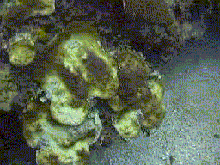What is Coral Bleaching?

Bleached corals at Glover’s Reef, Belize (Montastraea franksii – Mountainous Star Coral) and Agaricia lamarcki – Larmarks Sheet Cora)). Click image to see a video clip and credit (4.8MB, AVI format).
Reef-building corals require warm, tropical water—but how warm is too warm? Scientists have discovered that corals start becoming stressed if the water is only one degree warmer than the average temperature of the warmest summer month. This temperature is called the “bleaching threshold.”
Corals have symbiotic algae, called zooxanthellae, living within their body tissues. The algae provide crucial food and oxygen for the coral, and the algae get the benefit of nutrients and a safe growing environment. When corals are stressed, they expel the zooxanthellae. The algae give corals their distinctive colors; when the coral loses the algae, all you see is the white skeleton through the clear coral tissue and the coral appears “bleached.”

Photo of healthy golden-brown Acropora prolifera coral, photographed near Lee Stocking Island, Bahamas, February 2005. Click image for larger view and image credit.
If the temperatures do not get too high or high temperatures do not last too long, the bleaching will not be severe and the corals can recover. They gradually rebuild their stock of zooxanthellae, and will likely go on to live healthy lives. However, if the temperature rises significantly above the bleaching threshold or remains high for several weeks, severe bleaching will occur.
Corals without symbiotic algae lack their main food source, and they can eventually die. Those that do survive are more likely to be infected with diseases, just like a stressed person is more likely to get sick. These diseases can also kill corals months after the bleaching happened.
